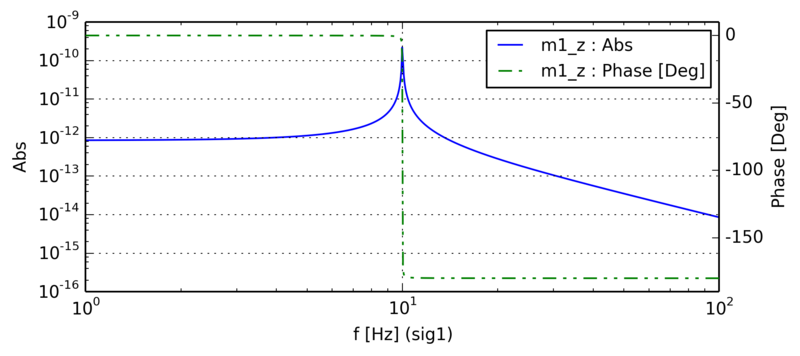Making a mirror move through radiation pressure
(An optics simulation with Finesse)
The following shows a simple example for a Finesse simulation of a radiation pressure effect, including the text input file, a brief explanation and the resulting plot.
The input file
%------------------------------------------------------------------------ % Finesse input file to plot the mirror motion due to radiation pressure % Daniel Brown 21.03.2014 %------------------------------------------------------------------------ # optical setup: laser, space and mirror: l l1 1 0 n1 s s1 1 n1 n2 m m1 1 0 0 n2 n3 # define transfer function with pole at 10Hz and Q factor 1000 tf pendulum 1 0 p 10 1000 # apply transfer function to mirror as force->motion attr m1 mass 1 zmech pendulum # measuring the mirror longitudinal motion xd m1_z m1 z # generate amplitude modulation at the laser fsig sig1 l1 amp 1 0 xaxis sig1 f log 1 100 400 yaxis log abs:deg
The optical layout

The optical layout is very simple with a laser beam being reflected by a single mirror. The interesting aspects of this setup are hidden in the details: The laser beam includes an amplitude modulation 'signal' whose frequency we can tune; secondly the mirror is suspended so that it acts like a free mass. The 'xd' detector is then used to plot the transfer function from laser amplitude fluctuations to the mirror's longitudinal motion.
Output graphs
Upon reflection by the mirror the photons reverse their momentum. This momentum transfer gives rise to a force on the mirror, the so-called `radiation-pressure force'. Finesse assumes a steady state of the optical system, which in this case means that we assume the static radiation-pressure force to be compensated by another static force, for example via active control or through gravity. The amplitude modulation signal on the laser light however creates a modulation of the force which we can model and measure in a steady state. The mechanical transfer function of the mirror determines how the longitudinal force (as a function of frequency) translates into motion. Thus the `xd' detector here essentially probes the shape this transfer function, a single pole at 10 Hz with a Q factor of 1000.



